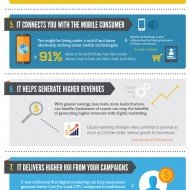Posted by Managementguru in SEO, Social Media
on Oct 14th, 2017 | 0 comments

How to Create the Perfect SEO Content? Write the content for the readers and not for keywords: Write your content for the readers based on the topic and related keywords you have researched meticulously and elaborate the topic. Add variations, synonyms and connected words throughout the content to make it more natural and at the same time SEO friendly. But it is worth paying to do the keyword research to find the kinds of words people actually use. Optimize your keyword: See to it that keywords are present in your URL, page title, start of the blog post, within the first 100 words, in your image alt text and in your Meta description. Yoast SEO wordpress plugin suggests all these things by default to guide you through SEO OPTIMIZATION. Read: Long Tail Keywords Create content 10x better than your competitors: Make the URL shorter: URL’s ranking #1 have only 50 characters on an average Include graphics, animations and videos: Interactive content creates 2x better engagement than static content. Create a better title which affects page ranking to a greater extent Make it simpler to read: The average Flesch readability score was 76.59, easily understood by 13 to 15 year old students Page rankings #1 had 15.8px font size on an average Make it faster: Don’t include lot of scripts and iframes in the homepage which might slow down the loading time Make it more visual: The average article ranking #1 has 9 images Make it more structured: Users want their answers fast as well as in a precise manner, say, in a bulleted list form 78% of the time Try to source professional photos or make your own infographic. Canva is the best site for beginners and pro’s to beautifully create designs at their own will Articles having images every 75 to 100 words get the most shares Floating share buttons increase the blog traffic by 27% Make it more linkable and shareable: Include relevant outbound links and lot of internal links; internal links make the readers stay in your website longer and relevant outbound links increase the authenticity of your blog/website Make it longer and resourceful that will help to increase the page ranking. Write well researched, planned and supported content for your audience How to format your content? Break your content into small sentences and paragraphs and make use of headings and sub-headings (H2, H3 etc.) Include quotes and tweetables to make the read more interesting and shareable. Sometimes your audience wants something shorter – or even different like podcasts and videos. Write your content for people first. But also remember you need to optimize for keywords too to get traffic from Google. How do you find a way out with content marketing? Set Objectives: Be clear about what you or your company wants to accomplish through content marketing. What are the objectives you have in mind to be realized through content strategies Define Your Audience: What would your audience want to read, attend, see or listen to and where are they? Create a content plan: Creating and scheduling a content calendar is very important to make your presence felt amongst your audience. Consistency is the key when it comes to beating your competitors. Be Tactical: Take care of your SEO, SOCIAL REACH AND PUBLIC RELATIONS to have a better reach Test and Analyze: Measure your response by tracking and reviewing your analytics and then refine your content based on the...

Posted by Managementguru in Business Management, How to Blog, SEO, Social Media
on Aug 1st, 2017 | 0 comments

How To Evaluate SEO Performance Most e-commerce managers are obsessed with rankings. They are always searching on Google for something to indicate that their rankings are getting better. When they notice changes in the search engine results, they assume that their search engine optimization (SEO) program’s performance is flawless. Unfortunately, this is not always true. Frank Abagnale, the Customer Success Manager of Semalt Digital Services, explains the real factors that influence your website’s ranking and performance. Competition: What else is ranking? Nowadays competition has outgrown the conventional organic search tactics used by competitors. Every e-commerce company owner wants the site to outrank their business rivals in order to improve visibility, get clicks and make a sale. However, most search queries set off elements in the search results that draw away attention from conventional organic results and push listings down the page. Personalization: Who is ranking? Today, rankings are highly customized to an extent that there are no longer impersonalized rankings for most searches. Basically, the rankings a consumer sees on his iPhone will be different from the rankings you see on your tablet or computer. As a result, no one can ever say with certainty “We rank first in Google!” Normally, rankings are customized based on: Location. This is the most common factor that influences personalization of rankings. When search engines determine the location of the user using a cell signal or device’s IP address, they deliver customized search results. Device usage. Rankings that appear on smartphones are not the same as those appearing on a desktop or tablet. Mobile devices usually get links into apps. As a result, sites with mobile-friendly experiences will rank higher. If a consumer is searching for something on the iPhone, the results will be very different from what appears on your desktop results. Search history. Every time you log into the search engine’s account, the search engine gets access to all your search history. A perfect example is when you log into your Gmail account on your computer, the search engine logs into your Google account and Google search. This information is used to customize the search results appearing on your device. Social behavior. Using platforms such as Twitter and Google+, Google gets full access to your social behavior. This explains why some content from brands or friends is displayed in your search results, but is not displayed when other people initiate search queries. Demographics. Search engines place every user into a demographic group using their past behavior to deliver highly targeted ads. Based on the factors stipulated above, you now understand how search engine results are customized. These factors give a preview of why ranking report tools are likely to return impersonalized data for a consumer even when your ranking tools indicate that you are ranking first for your most valuable keyword. A prospect may not see the same results from their end which means that they not likely to buy from you. This means that if a rank reporting tool cannot give accurate data to help your business generate income, then it is not a reliable tool to indicate performance. Representation: What keywords to choose? Tracking rankings means you choose a set of phrases and keywords that you would like to rank for and plot the performance of your site in ranking for those words. The phrases you choose have the potential to change the appearance of your performance. Most of the time, companies find it easy to use phrases and keywords they are already ranking for including their brand or words with low competition. This usually makes it appear as if their SEO performance is flawless even when it is not. On...

Posted by Managementguru in Marketing, Social Media, Startups, Technology
on Apr 8th, 2015 | 0 comments

Disclaimer: This content is curated and since information related to digital marketing is available aplenty on the Internet, I thought of compiling data in a sequential and comprehensive manner for the benefit of the readers. One of the easiest, fastest and cheapest ways for businesses to reach consumers today is via the Internet. Read on: Fed Fix: What is Inbound Marketing? This resourceful article explains essential inbound marketing strategies and tactics that companies can use to boost their campaigns’ effectiveness. Digital marketing, also known as Internet or online marketing, is quickly replacing print, television and radio advertisement as the marketing approach of choice for businesses of all sizes. Recent research revealed that 1 in 4 of every business-advertising dollar is dedicated to Internet marketing. Digital marketing uses internet connected devices such as smart phones, laptops and tablets to engage customers online via technologies such as web and email in conjunction with digital customer data such as characteristics and behaviour. Channels include display advertising, search engine optimisation (SEO) and search engine marketing (SEM). It also includes email, RSS, blogging, podcasting, video streams, social networks and instant response messaging. If you are looking for an edge over your competitors, a digital marketing strategy can provide many benefits to today’s savvy business owner. Benefits of Digital Marketing for Small Business 👇 Instant Access Wide reach to internet users in a single click. Cost Effective A well planned and targeted digital marketing campaign can help your business reach your target audience at a lower cost compared to traditional marketing tactics. Open 24/7 Your website is available to your target audience 24/7. Increases Customer Retention and Loyalty Engage with your customers in a more personalised way when you advertise your products and services. Community Building and Reputation Social media provides the perfect platform to build customer loyalty and build strong online reputation. Research Provides the possibility for an immediate response and feedback from today’s connected consumer. It’s Measurable Track your online campaign’s success in real time. Digital Marketing Channels or Campaigns Online marketing doesn’t only revolve around your website. Although this is an important part of it, you should be aware of other channels that will aid your digital marketing strategy. Whether you’re looking at low budget or blow–the- budget campaigns, these forms of digital marketing are ideal for small businesses as you can adapt your activity to suit your financial situation: 👇 Discover a huge collection of digital assets on Social Media Marketing here! 1. Content Marketing Your website is a powerful tool within your marketing strategy. Most of the time this is where you will be directing your customers to when you engage with them so it’s important to ensure you have interesting content to keep your customers on the site for longer. Start by keeping an interesting blog so that you can share relevant content with your customers and draw them to your site. With new technologies, more people are reading content on their mobile phones and tablets than ever before. It’s important to ensure your website is easy to browse and interact with on these different devices so that customers can have a good user experience on the move. 2. Search Engine Marketing Stay ahead of your competitors by driving traffic to your website using Search Engine Optimisation (SEO). It works by optimising your site to increase its organic ranking in search engine results (for example how high up you would appear in a search list on Google), so that customers will be more likely to visit your site. Search engine marketing focuses on improving your ranking using specific methods such as improving your use of keywords (words and phrases...






